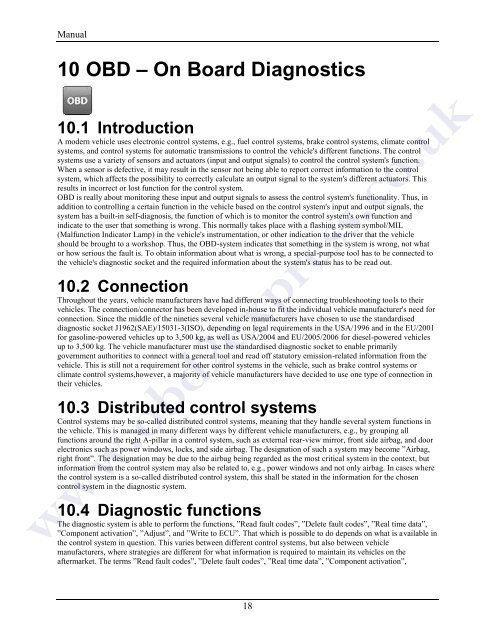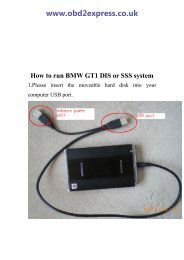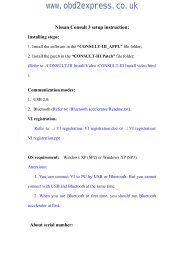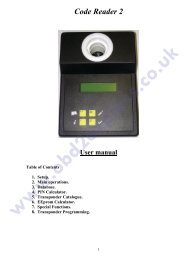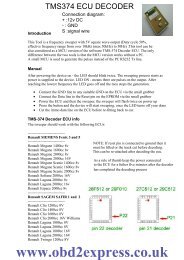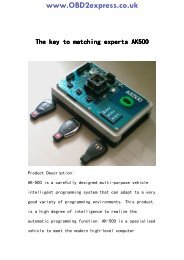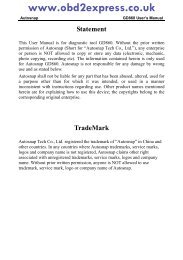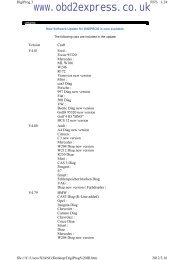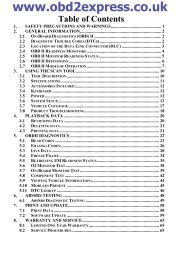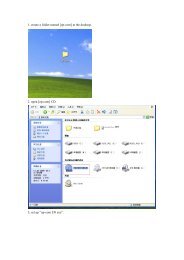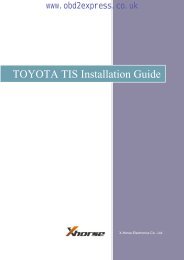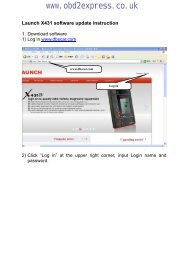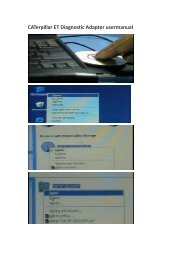autocom-cdp-pro-for-trucks-manual-version-1.5 - Car diagnostic tool
autocom-cdp-pro-for-trucks-manual-version-1.5 - Car diagnostic tool
autocom-cdp-pro-for-trucks-manual-version-1.5 - Car diagnostic tool
Create successful ePaper yourself
Turn your PDF publications into a flip-book with our unique Google optimized e-Paper software.
Manual10 OBD – On Board Diagnostics10.1 IntroductionA modern vehicle uses electronic control systems, e.g., fuel control systems, brake control systems, climate controlsystems, and control systems <strong>for</strong> automatic transmissions to control the vehicle's different functions. The controlsystems use a variety of sensors and actuators (input and output signals) to control the control system's function.When a sensor is defective, it may result in the sensor not being able to report correct in<strong>for</strong>mation to the controlsystem, which affects the possibility to correctly calculate an output signal to the system's different actuators. Thisresults in incorrect or lost function <strong>for</strong> the control system.OBD is really about monitoring these input and output signals to assess the control system's functionality. Thus, inaddition to controlling a certain function in the vehicle based on the control system's input and output signals, thesystem has a built-in self-diagnosis, the function of which is to monitor the control system's own function andindicate to the user that something is wrong. This normally takes place with a flashing system symbol/MIL(Malfunction Indicator Lamp) in the vehicle's instrumentation, or other indication to the driver that the vehicleshould be brought to a workshop. Thus, the OBD-system indicates that something in the system is wrong, not whator how serious the fault is. To obtain in<strong>for</strong>mation about what is wrong, a special-purpose <strong>tool</strong> has to be connected tothe vehicle's <strong>diagnostic</strong> socket and the required in<strong>for</strong>mation about the system's status has to be read out.10.2 ConnectionThroughout the years, vehicle manufacturers have had different ways of connecting troubleshooting <strong>tool</strong>s to theirvehicles. The connection/connector has been developed in-house to fit the individual vehicle manufacturer's need <strong>for</strong>connection. Since the middle of the nineties several vehicle manufacturers have chosen to use the standardised<strong>diagnostic</strong> socket J1962(SAE)/15031-3(ISO), depending on legal requirements in the USA/1996 and in the EU/2001<strong>for</strong> gasoline-powered vehicles up to 3,500 kg, as well as USA/2004 and EU/2005/2006 <strong>for</strong> diesel-powered vehiclesup to 3,500 kg. The vehicle manufacturer must use the standardised <strong>diagnostic</strong> socket to enable primarilygovernment authorities to connect with a general <strong>tool</strong> and read off statutory emission-related in<strong>for</strong>mation from thevehicle. This is still not a requirement <strong>for</strong> other control systems in the vehicle, such as brake control systems orclimate control systems,however, a majority of vehicle manufacturers have decided to use one type of connection intheir vehicles.10.3 Distributed control systemsControl systems may be so-called distributed control systems, meaning that they handle several system functions inthe vehicle. This is managed in many different ways by different vehicle manufacturers, e.g., by grouping allfunctions around the right A-pillar in a control system, such as external rear-view mirror, front side airbag, and doorelectronics such as power windows, locks, and side airbag. The designation of such a system may become ”Airbag,right front”. The designation may be due to the airbag being regarded as the most critical system in the context, butin<strong>for</strong>mation from the control system may also be related to, e.g., power windows and not only airbag. In cases wherethe control system is a so-called distributed control system, this shall be stated in the in<strong>for</strong>mation <strong>for</strong> the chosencontrol system in the <strong>diagnostic</strong> system.10.4 Diagnostic functionswww.obd2express.co.ukThe <strong>diagnostic</strong> system is able to per<strong>for</strong>m the functions, ”Read fault codes”, ”Delete fault codes”, ”Real time data”,”Component activation”, ”Adjust”, and ”Write to ECU”. That which is possible to do depends on what is available inthe control system in question. This varies between different control systems, but also between vehiclemanufacturers, where strategies are different <strong>for</strong> what in<strong>for</strong>mation is required to maintain its vehicles on theaftermarket. The terms ”Read fault codes”, ”Delete fault codes”, ”Real time data”, ”Component activation”,18


